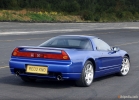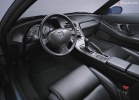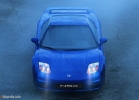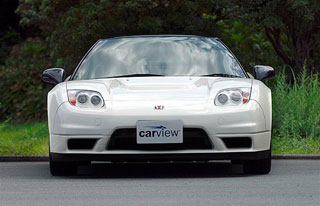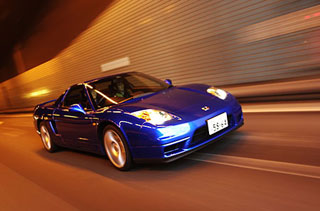Test drive Honda NSX 2002 - 2005 compartment
Comparison of supercars Honda NSX and Audi R8
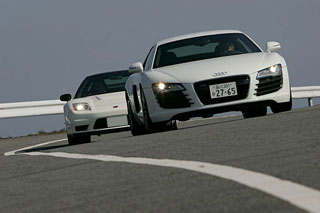 What is common between Audi R8 and Honda NSX cars?
What is common between Audi R8 and Honda NSX cars? As soon as I was driving and moved, I immediately felt: in this machine the sound in the cabin is not like that. It is not clear what I mean? I explain: in an aluminum capsule, a sound penetrating into the salon is not reflected in the same way in a salon made of iron. Theoretically, everything is clear: the vibration of aluminum is lower, which means the acoustics inside the salon should be different. But the theory is theory, and when you are convinced of this in practice, it is always as a revelation. The same can be said about weight: on all other things being equal, an aluminum body is a third more light than its iron counterpart, and, therefore, it is initially clear that this cannot but affect the behavior of the machine on the go. But it is one thing to know, guess, and feel completely different to feel this difference in practice.
But the thing is that between the Audi R8 and Honda NSX cars a whole era of 18, and when you get behind the wheel and begin to analyze your impressions, it turns out that there is a great similarity between them. Well, yes, both machines with aluminum bodies and with the same Midship layout (average engine location). However, there are differences, and even what! One has an engine with 8 cylinders, the other with 6. And besides, they are located at least behind, but one stands along and the other across the car. Yes, and yet: all -wheel drive and drive only on the rear wheels are, of course, far from the same thing. But,
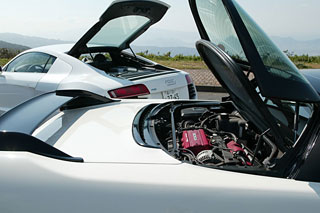 nevertheless, all these significant differences cannot hide the main similarity: both body cars are completely aluminum, and precisely why they seem almost relatives.
nevertheless, all these significant differences cannot hide the main similarity: both body cars are completely aluminum, and precisely why they seem almost relatives. Of course, in the ability to quickly move the NSX car, and in particular its varieties R, you can’t refuse, this is so. However, when after it you get behind the wheel Audi R8, the existing age difference of 18 years still makes itself felt. In other words, you are quite clearly begin to understand that all these years the technique did not stand still, but moved forward and improved. The similarity is similar, but the Honda car is the main advantage of this ability to move quickly, while the R8 is an example of a sports car of a new time, which, as is commonly believed, should be not only high -speed, but also comfortable.
Material for the manufacture of the body yes, the same, aluminum. But if Honda, when developing a NSX model, sought to make a sports car in its pure form, then what about the R8 machine, when working on it, Audi designers, apparently, were forced to take into account new trends, the essence of which, they say, is a sport In its pure form, this is already yesterday, and you can’t go far at cleanliness alone. So it turns out that, although the reason for using aluminum with Honda and Audi has one struggle with excess weight, the benefit gained, as it seemed to me, they used each in its own way.
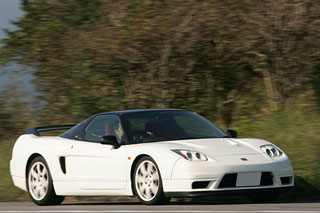 Feeling of genuine unity plus excitement
Feeling of genuine unity plus excitement I think that I will not be mistaken if I assume that most readers still consider the Honda NSX model a little strange: on the one hand, a completely aluminum body, and on the other, a 6-cylinder engine standing across the body in order to leave a place for the rear trunk , in which you can put a bag with accessories for playing golf.
In fact, this is nothing more than a misconception, which is explained by the fact that at that time there were many such experts who believed and wrote that, they say, Honda designers, instead of sequentially achieve the main goal of increasing the efficiency (utility coefficient) Their cars were distracted by all sorts of secondary little things there. And what, for example, was said by the chief engineer of the project of Mr. Wechar about the fact that preference was given to the 6-cylinder engine? He said that it could not be otherwise, because, they say, NSX is a middle -class car, nothing more. But this was quite obvious: from the very beginning, the NSX model was planned as an analogue of the German Porsche 911, and, judging by its traction characteristic, one of the most successful.
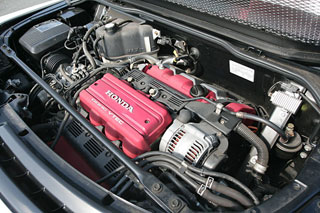 But if this is so, if the NSX is a really sports car of the middle class, it becomes clear: the engine that was planned to be put on the car should not only be powerful, but also to be compact and not too heavy. And at that time, Honda has already developed the original VTEC system (a system of unacceptable change in gas distribution phases), which made it possible to achieve the desired high-speed characteristic from only a 3-liter engine. The transverse location of the engine also has its explanation. The essence came down to the fact that it was important for the designers to press the engine as close to the ground as possible, but it was impossible to increase the wheelbase, because it was no less important to ensure that the machine impressed the monolith. There was only one to place the motor right in the middle between the front and rear bridge. And how was it to do if you do not expand it 90 degrees and put it not along, but across the body? By the way, in order to achieve the same dynamics with the longitudinal location of the motor, I would have to increase the wheelbase, and this, as I said, was extremely undesirable. Yes, and there would be no room for the trunk. Yes, you look at R8! After all, its full length is almost the same, but the engine stands along the car, and that’s all, no trunk! Maybe someone will say: well, no, and don’t!. But, they say, this notorious efficiency is higher. But is this a matter, even if a sports bag with gloves and helmet is nowhere to put?! And there is nothing to say about passengers. But the NSX car still has a trunk, and what's wrong with that?
But if this is so, if the NSX is a really sports car of the middle class, it becomes clear: the engine that was planned to be put on the car should not only be powerful, but also to be compact and not too heavy. And at that time, Honda has already developed the original VTEC system (a system of unacceptable change in gas distribution phases), which made it possible to achieve the desired high-speed characteristic from only a 3-liter engine. The transverse location of the engine also has its explanation. The essence came down to the fact that it was important for the designers to press the engine as close to the ground as possible, but it was impossible to increase the wheelbase, because it was no less important to ensure that the machine impressed the monolith. There was only one to place the motor right in the middle between the front and rear bridge. And how was it to do if you do not expand it 90 degrees and put it not along, but across the body? By the way, in order to achieve the same dynamics with the longitudinal location of the motor, I would have to increase the wheelbase, and this, as I said, was extremely undesirable. Yes, and there would be no room for the trunk. Yes, you look at R8! After all, its full length is almost the same, but the engine stands along the car, and that’s all, no trunk! Maybe someone will say: well, no, and don’t!. But, they say, this notorious efficiency is higher. But is this a matter, even if a sports bag with gloves and helmet is nowhere to put?! And there is nothing to say about passengers. But the NSX car still has a trunk, and what's wrong with that? 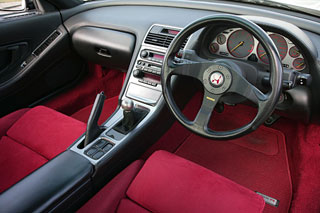 In fact, Honda designers, who were developing the NSX model, could be accused of anything, but not that they allegedly did not think about economic indicators. Where else will you find a middle -class car that would have such a small fuel consumption with such a dynamics? And all thanks to the aluminum body, a small weight, but a powerful engine (even if someone does not like that it is 6-cylinder), well, and the transverse location of this engine. What happened in the end? Yes, only that, being a middle-class machine, it is quite capable of overtaking many sports cars with a class higher, including Ferrari with all its 8 cylinders! Oh, yes, I agree: in connection with the appearance of the new Audi R8, which has the same Midship layout as NSX, everyone realized that such machines can be simple and convenient to drive. But, nevertheless, I take the liberty of saying whatever it was, but such a feeling of close unity of the driver with the car, such excitement as the NSX wheel, you will not experience anywhere else. Even if you control Audi R8, this is the whole difference!
In fact, Honda designers, who were developing the NSX model, could be accused of anything, but not that they allegedly did not think about economic indicators. Where else will you find a middle -class car that would have such a small fuel consumption with such a dynamics? And all thanks to the aluminum body, a small weight, but a powerful engine (even if someone does not like that it is 6-cylinder), well, and the transverse location of this engine. What happened in the end? Yes, only that, being a middle-class machine, it is quite capable of overtaking many sports cars with a class higher, including Ferrari with all its 8 cylinders! Oh, yes, I agree: in connection with the appearance of the new Audi R8, which has the same Midship layout as NSX, everyone realized that such machines can be simple and convenient to drive. But, nevertheless, I take the liberty of saying whatever it was, but such a feeling of close unity of the driver with the car, such excitement as the NSX wheel, you will not experience anywhere else. Even if you control Audi R8, this is the whole difference! 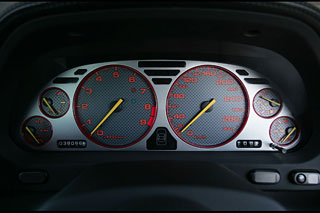
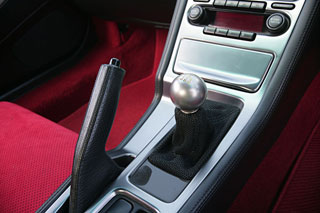
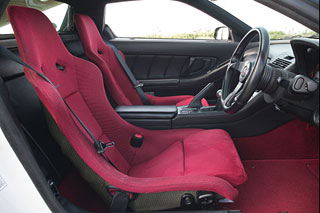
What is more correct, Sport Premium or Sport in kind?
So, I repeat, when developing a Honda NSX car, everything was done to maximize its efficiency: they created an aluminum body, selected a relatively light 6-cylinder engine, which was also put across the body, which, you see, is not quite usually. And then they constantly worked on his high -speed data, so today the modification R has become, of course, the best middle -class sports car.
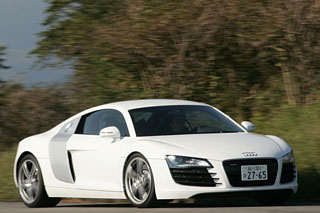 But then another Audi R8 sports car appears, which also has an aluminum body, and the same Midship layout. But I wonder what Audi designers achieved, making an aluminum sports car, and did they achieve what they wanted? It is clear that the lighter the body, the less fuel consumption at the same speed. Calculations show that, all other things being equal, an iron body would be 200 kg heavier, so an increase in efficiency is an undeniable fact. But if Honda was mainly concerned about this particular efficiency, then Audi, apparently, looks at the problem somewhat wider.
But then another Audi R8 sports car appears, which also has an aluminum body, and the same Midship layout. But I wonder what Audi designers achieved, making an aluminum sports car, and did they achieve what they wanted? It is clear that the lighter the body, the less fuel consumption at the same speed. Calculations show that, all other things being equal, an iron body would be 200 kg heavier, so an increase in efficiency is an undeniable fact. But if Honda was mainly concerned about this particular efficiency, then Audi, apparently, looks at the problem somewhat wider. See: the appearance of the first Audi car with a body made completely of aluminum happened in 1994, that is, 4 years after the sensational debut of the Honda NSX car. Let me remind you that it was the Audi A8 model. But if Honda has chosen Monocok's frameless body for its sports car, Audi has gone differently and created the spatial frame of ASF (Audi Space Frame). And then she purposefully led the refinement of this frame, using it not only in A8 subsequent generations, but even by testing it on low -command A2. Then there were two more generations TT, in which, however, the body was half of aluminum, half of iron, and now, finally, it was decided to make an aluminum frame for sports R8. Such perseverance and determination convincingly indicates that the spatial aluminum body has become not just a means of solving private problems for designers, but was chosen as a priority or, more precisely, Audi branded technology. This company
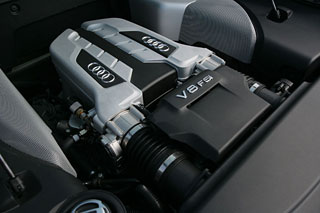 as you know, there is already what it considers to be its branded skate is a Quattro all-wheel drive system, which, along with the design and quality of the finish, has become a constant attribute of premium machines. And now, apparently, Audi has another such sign of distinction. That is, all this bustle around the aluminum body was also needed in order to support the Audi brand.
as you know, there is already what it considers to be its branded skate is a Quattro all-wheel drive system, which, along with the design and quality of the finish, has become a constant attribute of premium machines. And now, apparently, Audi has another such sign of distinction. That is, all this bustle around the aluminum body was also needed in order to support the Audi brand. So, a light aluminum body on the one hand increases the efficiency of the machine, and on the other, it should indicate the high technical potential of the company that produces it. Therefore, at present, the R8 car is not just a new model, it is part of the Audi strategy, not otherwise. Indeed, in this car one car is concentrated by the whole arsenal that the company owns: here you have a direct injection system, Quattro, and ASF, and plus first -class design and quality. There are no complaints about the saturation of various kinds of equipment and cannot be, the only exception that the car’s weight was more than one could assume. If, for example, to leave only the equipment, without which it was simply nothing, it was possible to play 200 kilograms, bringing the total weight of the machine to 1,400 kg. But what does the necessary minimum mean when it comes to the car
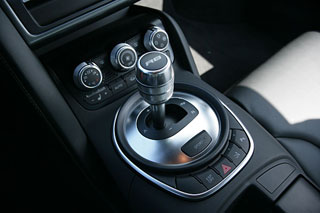 premium class? Thus, on the one hand, there is a struggle with excess weight, but on the other hand, it turns out that this struggle is directed only against the prestigious weight for weight, which can increase the prestige of the car and the company that produces it. So it turns out that for Audi the main thing is sport, but not in a pure, refined form, but in a beautiful, glossy wrapper. But what to do if, I repeat, these are new trends? It is stupid to ignore, it means that, as they say, to correspond.
premium class? Thus, on the one hand, there is a struggle with excess weight, but on the other hand, it turns out that this struggle is directed only against the prestigious weight for weight, which can increase the prestige of the car and the company that produces it. So it turns out that for Audi the main thing is sport, but not in a pure, refined form, but in a beautiful, glossy wrapper. But what to do if, I repeat, these are new trends? It is stupid to ignore, it means that, as they say, to correspond. In contrast to this, the Honda NSX car, in which everything is aimed at solving one problem as the maximum increase in its efficiency, seems to be a natural athlete (sports, then sports!). But the trouble currently does not correspond to the current idea of \u200b\u200bwhat a sports car should be. Then the question is appropriate: which of the two mentioned sports cars should be considered correct? I believe that there is no unequivocal answer to this question. Both are right in their own way!, I would say so.
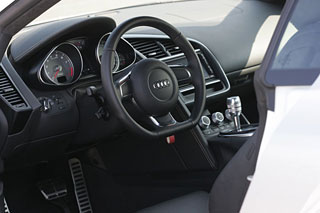
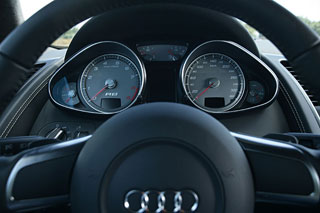
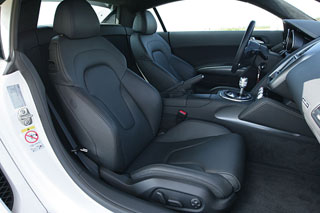
Will this raise the prestige of the brand, that's the question
After all of the above, we will return again to the assessment of the directly running qualities of both machines. And then it seems to me that the Honda NSX car is, without a doubt, a completely unique project. In fact, the model has existed for more than 18 years, and nevertheless, it has not yet lost its relevance, and even against the backdrop of modern analogues can pass and charm. After all, if you make a new model, following the old concept, then only due to the improvement of aluminum technology can the weight of the machine be reduced to 1,100 kg. This is if you do not change its size. Of course, if you increase the size of the machine, but equip it, as they say, in full scheme, then the weight in it will increase, however, in this case, everything can be limited to 1,300 kilograms. For a car with a similar weight, a 6-cylinder V-shaped engine with a working volume of 3.5 liters and a capacity of 300 to 350 hp. It would be more than sufficient. And fuel consumption would remain low. It is possible that with an increase in the size of the body, the engine could not be put across, but along the machine. Well, then further, of course, there are even more tempting prospects,
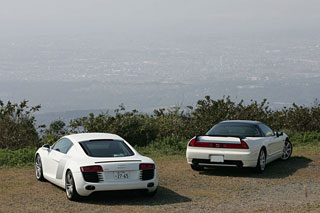 associated with the advent of an 8-cylinder engine. All this does not contradict the concept of the NSX that was chosen even then, in previous years, but which is now quite suitable for the production of a modern sports car.
associated with the advent of an 8-cylinder engine. All this does not contradict the concept of the NSX that was chosen even then, in previous years, but which is now quite suitable for the production of a modern sports car. In a word, if the Honda designers set themselves the task of developing a super -speed sports car on the basis of the NSX, they would have succeeded in the best possible way. For Honda, this would be all the more important that she simply did not have any other impressive car. As for the Audi car, attempts to combine an aluminum body with the design and quality of premium finish makes this machine similar to all other models of this brand, so the essence of a purely sports car begins to blur.
So what do we have in the end? Both that and another company seeks to actively use aluminum in its machines, and in this regard it can be argued that both of them demonstrate a commitment to the same philosophy. At the same time, each of these brands, or, as they say now, brands have their own face. So, the question is whether this hobby for aluminum technology will lead to an increase in the prestige of the brand itself, or not. And here we must admit that Audi has chosen the correct, successful line, since the trend that can be called Premium Sport does not contradict our idea of \u200b\u200bwhat the real Audi is. As for the Honda brand, then not everything is so clear. Of course, the new generation of the NSX model in principle has every chance, as they say, to support the brand, but whether this can actually happen, it is too early to talk about it.
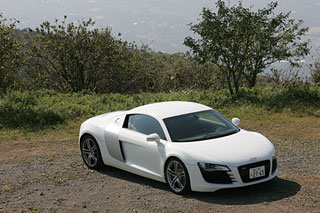 Technical characteristics of the Audi R8 FSI Quattro car
Technical characteristics of the Audi R8 FSI Quattro car Full length: 4 435 mm.
Full width: 1 905 mm.
Complete height: 1 250 mm.
Wheel base: 2 650 mm.
Machine weight: 1 630 kg.
Drive: 4wd.
Engine: 4.2-liter 8-cylinder with a V-shaped cylinder location, DOHC gas distribution mechanism, developed power 309 kW (420 hp) at 7,800 rpm, the largest torque 430 nm (43.8 kg- m) at 6,000 rpm.
Transmission: a 6-speed boxaboutomat.
The basic price of the car: 16 million 700 thousand yen ($ 166 500).
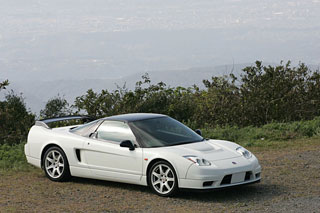 Technical characteristics of the Honda NSX-R car
Technical characteristics of the Honda NSX-R car Full length: 4 430 mm.
Full width: 1 810 mm.
Complete height: 1 160 mm.
Wheel base: 2 530 mm.
Machine weight: 1 270 kg.
Drive: on the rear wheels.
Engine: a 3.2-liter 6-cylinder with a V-shaped cylinder location, DOHC gas distribution mechanism, developed power 206 kW (280 hp) at 7,300 rpm, the largest torque 304 nm (31.0 kg- m) at 5,300 rpm.
Transmission: 6-speed manual
Basic (corrupt) price of the car: 12 554 800 yen ($ 125,000).
Source: CarView.co.jp


